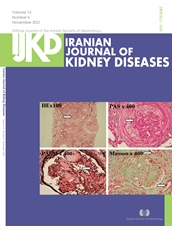Prognostic Value of Blood Pressure Responsiveness in Hemodialysis for Cardiovascular Mortality, Development of A New Predictive Equation
Abstract
Introduction. Cardiovascular disease is considered as the main cause of mortality and morbidity in HD-patients and AS is a fundamental cause. This study was conducted to investigate whether intradialytic BP changes can use as a surrogate clinical marker. Methods. Fifty-one patients on maintenance hemodialysis, for at least 12 hours per week, were included in a prospective cohort study. Intradialytic BP was measured using validated automated device. PWV was performed to assess Augmentation Index (AIx) as marker of arterial stiffness. All measurements were repeated in alive individuals after 5 years of follow-up. Patients with 5% reduction of intradialytic BP were considered as HD-responsive and Several statistical analyses were employed based on responsiveness to HD. Results. After 5-year follow-up the findings demonstrated BP response to HD was an important and independent determinant of mortality (P < .05). Augmentation index (AIx) (P < .05), heart rate (P < .05), and calcium phosphate product (P < .05) as well as log PTH (P < .05) were significantly different between two responsive and non-responsive to HD. Pearson’s Correlation studies revealed a significant relationship between the BP response to HD and heart rate (r = 0.4, P < .05), LVEF (r = -0.4, P < .05) and PTH (r = -0.3, P < .05). BP response to HD and log-PTH remained significant even after age and gender adjustment (P < .05). Conclusion. BP-response to HD can use as a clinical and surrogate marker of AS which is significantly associated with mortality and LVEF. Arterial stiffness and intradialytic BP can predict the changes in Ejection Fraction (EF).
DOI: 10.52547/ijkd.6810
Downloads
Download data is not yet available.
Downloads
Published
2021-12-20
Issue
Section
ORIGINAL | Dialysis
How to Cite
Prognostic Value of Blood Pressure Responsiveness in Hemodialysis for Cardiovascular Mortality, Development of A New Predictive Equation. (2021). Iranian Journal of Kidney Diseases, 15(6), 441-450. https://ijkd.org/index.php/ijkd/article/view/6810


